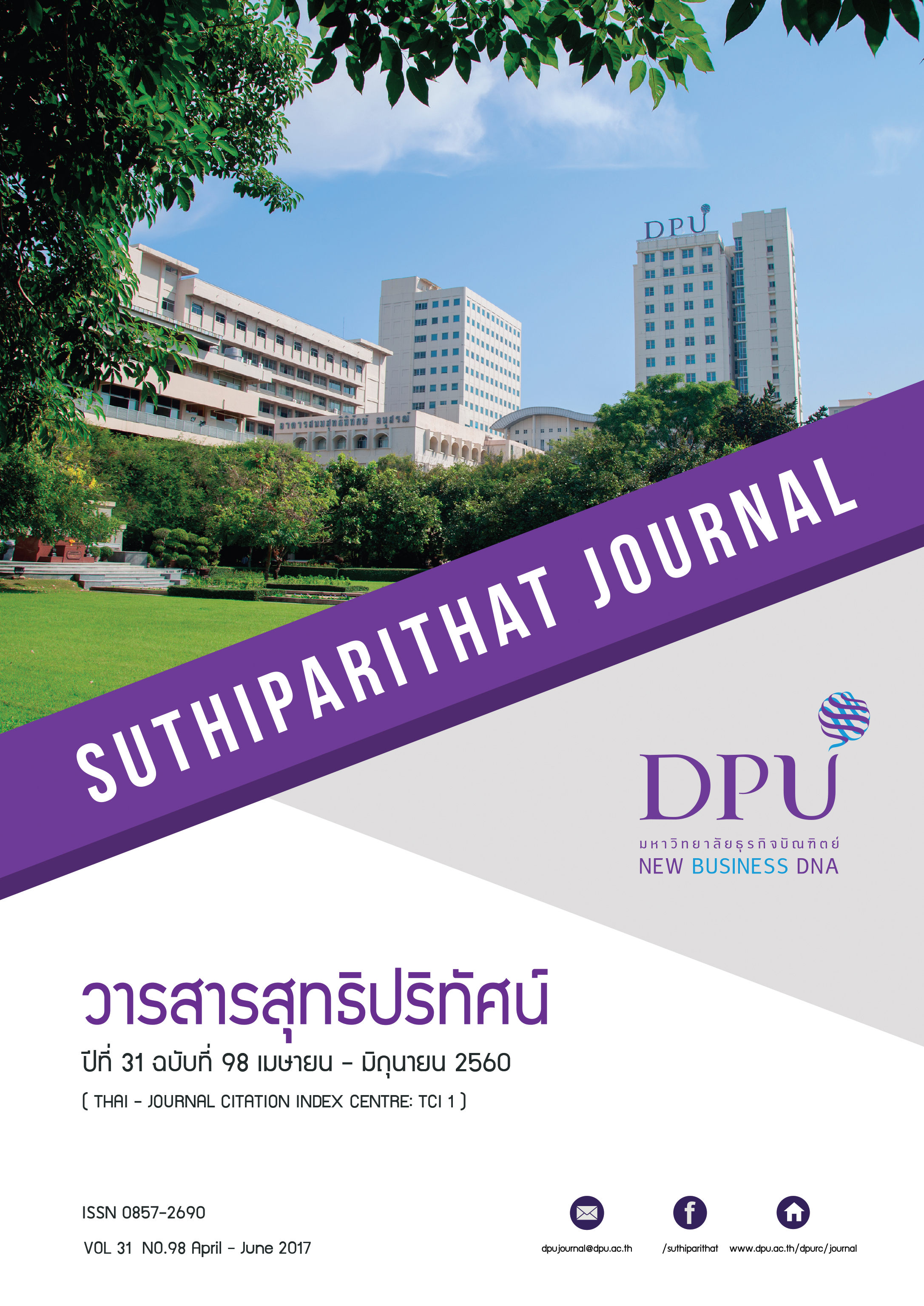อิทธิพลของบรรยากาศแห่งความสุขและความอัศจรรย์ภายในองค์การที่มีต่อความรู้สึกพึงพอใจและความรู้สึกผูกพันของบุคลากร: กรณีศึกษารัฐวิสาหกิจแห่งหนึ่ง
คำสำคัญ:
บรรยากาศแวดล้อมในองค์การ, ความพึงพอใจของบุคลากร, ความผูกพันของบุคลากรบทคัดย่อ
บรรยากาศแวดล้อมในองค์การมีความอิทธิพลต่อการเกิดความรู้สึกพึงพอใจและความรู้สึกผูกพันของบุคลากร การวิจัยครั้งนี้เป็นการวิจัยเชิงสำรวจเก็บข้อมูลจากบุคลากรที่ทำงานในองค์การรัฐวิสาหกิจแห่งหนึ่งเลือกกลุ่มตัวอย่างแบบตามสะดวกจำนวน 747 คน จากบุคลากรทั้งหมด 894 คน
ทดสอบสมมุติฐานการวิจัยด้วยสถิติเชิงอนุมาน ด้วยการวิเคราะห์สมการถดถอยพหุคูณแบบ เป็นขั้นตอน (Stepwise multiple regression analysis) ผลการศึกษาพบว่า อิทธิพลของของบรรยากาศแห่งความสุข (HAPPY Satisfaction Climate) มีเพียงสามด้านที่มีอิทธิพลต่อความรู้สึกพึงพอใจคือ ปัจจัยด้านความก้าวหน้า (Promotion) ปัจจัยด้านเพื่อนร่วมงาน (Associate) และปัจจัยด้านสภาพแวดล้อมในที่ทำงาน (Happy Office) สถิติแสดงความสัมพันธ์ข้อมูลมีความสัมพันธ์ทางบวกในระดับสูง (r = 0.637, p < 0.01) และบรรยากาศแห่งความอัศจรรย์ที่ทำให้เกิดความผูกพัน (MAGIC Engagement Climate) มีเพียงสามด้านที่มีอิทธิพลต่อความรู้สึกผูกพันคือ ปัจจัยด้านความสำคัญของงาน (Meaning) ปัจจัยด้านการมีอำนาจและตัดสินใจ (Autonomy) และปัจจัยด้านการเรียนรู้และเติบโต (Growth) สถิติแสดง ความสัมพันธ์ข้อมูลมีความสัมพันธ์ทางบวกในระดับสูง (r = 0.726, p < 0.01)
เอกสารอ้างอิง
เปิดโลกอาชีพ (2560). สืบค้น 13 มกราคม 2560, จาก http://techno.knw.ac.th/images/bussiness1.pdf.
รชยา ภูวดลกิจ, ศยามล เอกะกุลานันต, และอภิญญา หิรัญวงษ. (2560). อิทธิพลของเจนเนอเรชั่นในองค์การ ค่านิยมในการทำงาน และการสนับสนุนจากองค์การทีมีต่อความผูกพันต่อองค์การของบุคลากร การไฟฟ้าส่วนภูมิภาค (สำนักงานใหญ่). วารสารสุทธิปริทัศน์, 31(97), 207-219.
วริทธิ์ธร ศรีสุจารักษ์ และวนิดา พลเดช. (2559). บรรยากาศแวดล้อมสำคัญที่ส่งผลให้เกิดความพึงพอใจและความผูกพันของพนักงานธนาคารพาณิชย์แห่งหนึ่งที่ปฏิบัติงานในสาขาห้างสรรพสินค้า 5 ระดับช่วงอายุการทำงาน. ในประชุมวิชาการทางธุรกิจและนวัตกรรมทางการจัดการระดับชาติและนานาชาติ ประจำปี 2559 (น.1000-1007) ขอนแก่น: มหาวิทยาลัยขอนแก่น.
Kinicki, A. J., Mckee-Ryan, F. M., Schriesheim, C. A., & Carson, K. P. (2002). Assessing the construct validity of the job descriptive index: A review and meta-analysis. Journal of Applied Psychology, 87(1), 14-32.
Litwin, G.H., & Stringer, R. A., Jr. (1968). Motivation and organizational climate. Division of Research. Boston, USA: Harvard Business School Press.
Macey, W. H., Schneider, B., Barbera, K. M., & Young, S. A. (2009). Employee Engagement:Tools for Analysis, Practice, and Competitive Advantage. Chichester: Wiley-Blackwell.
Maylett, T., & Warner, P. (2014). MAGIC: Five Keys to Unlock the Power of Employee Engagement. USA: Greenleaf Book Group Press, Austin.
McShane, S. L., & Von Glinow, M. A. (2015), Organizational Behavior7/e (Global Edition). New York: McGraw-Hill Education.
Robertson-Smith, G., & Markwick, C. (2009). Employee Engagement A review of current thinking. Institute for Employment Studies. Brighton, UK: University of Sussex Campus.
Schwartz, S. H. & Boehnke, K. (2004). Evaluating the structure of human values with confirmatory factor analysis. Journal of Research in Personality, 38, 230–255.
Schyns, B., Van Veldhoven, M., & Wood, S. (2009). Organizational climate, relative psychological climate and job satisfaction. The example of supportive leadership climate. Leadership and Organization Development Journal, 30, 649 - 663.
Steers, R. M., & Porter, L.W. (1991). Motivation and work behavior. New York: McGraw-Hill.
ดาวน์โหลด
เผยแพร่แล้ว
รูปแบบการอ้างอิง
ฉบับ
ประเภทบทความ
สัญญาอนุญาต
เนื้อหาและข้อมูลในบทความที่ลงตีพิมพ์ในวารสารสุทธิปริทัศน์ ถือเป็นข้อคิดเห็นและความรับผิดชอบของผู้เขียนบทความโดยตรงซึ่งกองบรรณาธิการวารสาร ไม่จำเป็นต้องเห็นด้วย หรือร่วมรับผิดชอบใด ๆ
บทความ ข้อมูล เนื้อหา รูปภาพ ฯลฯ ที่ได้รับการตีพิมพ์ในวารสารสุทธิปริทัศน์ ถือเป็นลิขสิทธิ์ของวารสารสุทธิปริทัศน์หากบุคคลหรือหน่วยงานใดต้องการนำทั้งหมดหรือส่วนหนึ่งส่วนใดไปเผยแพร่ต่อหรือเพื่อกระทำการใด ๆ จะต้องได้รับอนุญาตเป็นลายลักษณ์อักษรจากวารสารสุทธิปริทัศน์ก่อนเท่านั้น







